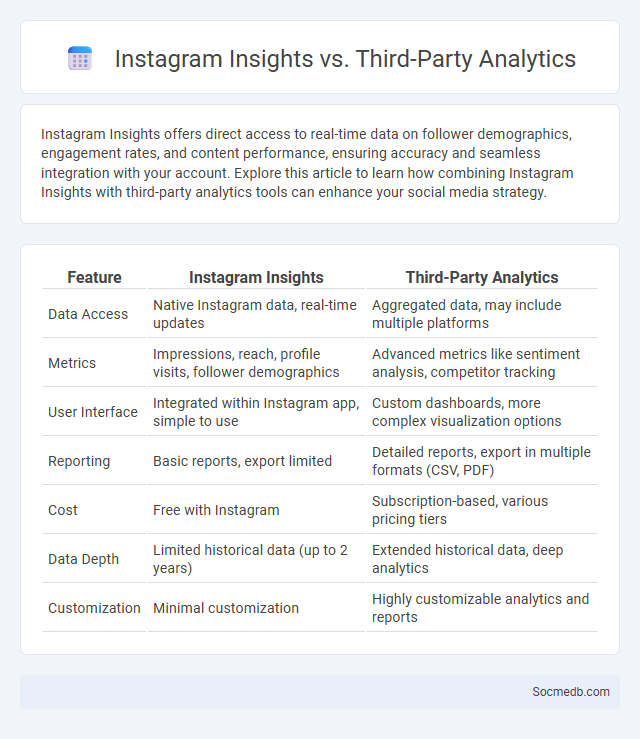
Photo illustration: Instagram Insights vs Third Party Analytics
Instagram Insights offers direct access to real-time data on follower demographics, engagement rates, and content performance, ensuring accuracy and seamless integration with your account. Explore this article to learn how combining Instagram Insights with third-party analytics tools can enhance your social media strategy.
Table of Comparison
| Feature | Instagram Insights | Third-Party Analytics |
|---|---|---|
| Data Access | Native Instagram data, real-time updates | Aggregated data, may include multiple platforms |
| Metrics | Impressions, reach, profile visits, follower demographics | Advanced metrics like sentiment analysis, competitor tracking |
| User Interface | Integrated within Instagram app, simple to use | Custom dashboards, more complex visualization options |
| Reporting | Basic reports, export limited | Detailed reports, export in multiple formats (CSV, PDF) |
| Cost | Free with Instagram | Subscription-based, various pricing tiers |
| Data Depth | Limited historical data (up to 2 years) | Extended historical data, deep analytics |
| Customization | Minimal customization | Highly customizable analytics and reports |
Introduction to Instagram Analytics Tools
Instagram analytics tools provide detailed insights into follower engagement, content performance, and audience demographics, enabling you to measure the effectiveness of your social media strategy. These tools track key metrics such as impressions, reach, profile visits, and follower growth, helping businesses optimize their posts and campaigns for better results. Using Instagram analytics, you can identify trends and tailor content to increase your brand's visibility and user interaction.
Overview of Instagram Insights
Instagram Insights provides detailed analytics on follower demographics, engagement rates, and content performance, enabling users to track metrics such as reach, impressions, and profile visits. This tool helps businesses and creators understand audience behavior and optimize posting strategies by analyzing data from posts, stories, reels, and IGTV. Leveraging Instagram Insights supports informed decision-making to enhance brand visibility and drive higher user interaction.
Key Features of Third-Party Analytics Platforms
Third-party analytics platforms for social media offer comprehensive data tracking, audience segmentation, and real-time engagement metrics to optimize your content strategy. These tools provide advanced sentiment analysis and competitor benchmarking, enabling precise performance insights across multiple social channels. You can leverage customizable dashboards and automated reporting to make data-driven decisions that enhance your social media impact.
Comparing Data Accuracy and Depth
Social media platforms collect vast amounts of user-generated content, providing real-time data with high volume but varying levels of accuracy and depth. Your ability to analyze trends depends on the precision of data extraction methods and the depth of user interactions captured, such as comments, shares, and reactions. Advanced analytics tools leverage machine learning to enhance data accuracy while extracting deeper insights from complex social media behaviors.
Content Creator Perspective: What Metrics Matter Most?
Engagement rate, follower growth, and content reach are the most critical metrics for social media content creators aiming to maximize their impact. Monitoring average watch time and click-through rates helps you understand how well your content resonates and drives action. Prioritizing these data points enables more informed decisions to optimize your strategy and grow your online presence effectively.
Customization and Reporting Flexibility
Social media platforms offer extensive customization options that enable you to tailor content, targeting, and advertising strategies to specific audience segments, enhancing engagement and ROI. Reporting flexibility provides detailed analytics and real-time insights, allowing you to track campaign performance, user behavior, and key metrics across multiple channels. Leveraging these features ensures your social media efforts are data-driven, adaptable, and optimized for maximum impact.
Ease of Use and Accessibility
Social media platforms prioritize ease of use by offering intuitive interfaces that allow users to quickly navigate and share content without technical barriers. Accessibility features such as screen reader compatibility, adjustable text sizes, and voice commands ensure that Your experience remains inclusive regardless of physical abilities. These design elements collectively enable seamless interaction, fostering greater user engagement and connectivity.
Cost Comparison: Free vs Paid Analytics
Free social media analytics tools, such as Facebook Insights and Twitter Analytics, offer basic metrics like engagement rates, reach, and follower demographics, making them suitable for small businesses or individuals with limited budgets. Paid analytics platforms like Hootsuite, Sprout Social, and Brandwatch provide advanced features including sentiment analysis, competitive benchmarking, and customizable reporting, often resulting in higher accuracy and deeper insights. Investing in paid solutions can significantly enhance decision-making and campaign performance, despite higher costs ranging from $100 to $1,000+ monthly.
Which Tool Suits Different Content Creator Needs?
Choosing the right social media tool depends on your content type and goals; Instagram excels for visual creators with its photo and video features, while Twitter suits those focused on concise text updates and real-time interaction. YouTube is ideal for long-form video content, supporting in-depth tutorials and storytelling, whereas TikTok thrives on short, engaging clips perfect for viral trends and younger audiences. LinkedIn caters to professionals aiming to share industry insights and network, making it the go-to for business-focused content creators.
Final Verdict: Choosing the Right Analytics Solution
Selecting the right social media analytics solution depends on factors like real-time data accuracy, platform integration, and user-friendly dashboards. Advanced tools such as Hootsuite Insights, Sprout Social, and Google Analytics provide comprehensive metrics that track engagement, audience demographics, and content performance. Prioritizing a solution with AI-driven insights and customizable reports ensures actionable strategies that boost social media ROI effectively.
 socmedb.com
socmedb.com